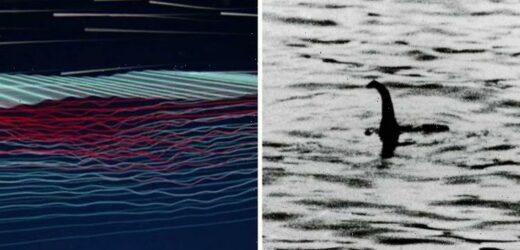'Loch Ness Monster' spotted roaming in the Scottish Highlands
We use your sign-up to provide content in ways you’ve consented to and to improve our understanding of you. This may include adverts from us and 3rd parties based on our understanding. You can unsubscribe at any time. More info
Nessie – the Loch Ness monster – has remained deep in the imagination of those who believe in local folklore for years. Often described as a large, long-necked dinosaur-like creature, the first recorded mention of the beast was in 565 AD in Adomnán’s, ‘Life of St Columbia’. Here that the abbot wrote about Saint Columba, who is credited with spreading Christianity throughout Scotland, around a century after the events happened. He said Columba encountered locals burying a man who had been killed by a “water beast” on the River Ness.
Adomnán sent one of his followers to find the creature who, on happening upon Nessie, made the sign of the cross and said: “Go no further. Do not touch the man. Go back at once”, to which the creature stopped and turned away.
In the modern era, little mention of Nessie made national news until the late 19th century when D. Mackenzie of Balnain reportedly saw an object resembling a log or an upturned boat “wriggling and churning up the water” in 1872.
Ever since, the idea of a monster has attracted people from all over the world to the picturesque scenery of Loch Ness deep in the Scottish Highlands.
Science has for decades attempted to give a more rational explanation other than some prehistoric beast managing to survive for millennia.


One method, explored during Channel 5’s documentary, ‘Drain the Oceans’, could put the mystery to bed.
Researchers have long since compared Russia’s great Lake Baikal with Loch Ness, the former being host to several mysterious natural feats, like giant rings on its surface that can be seen from space.
Under the ice of Baikal, scientists found what they described as an environment being “in turmoil”: a huge mass of water deep down is in constant rotation, caused by plumes of hot air from ancient volcanoes on the lake bed.
Cold winds that blow over the lake chill the top layers of the water; these then sink, and warmer layers below rise, creating immense currents which eventually form powerful swirling eddies.
JUST IN: NASA under pressure to rename flagship telescope over anti-LGBT claims

With their powerful columns of warm water, the eddies corkscrew around, thinning the ice above them and form the great rings.
The narrator asked: “Could Loch Ness contain forces just as strange and surprising as those in Baikal? And if so, could they account for some of the most common monster sightings?”
As the summer sun heats the surface of Loch Ness, it creates a thin layer of warm water on top of the denser, colder water below.
When the wind blows, it pushes that warmer layer up the length of the Loch.
DON’T MISS
Archaeologists astounded by ‘first ever image of Tower of Babel’ [REPORT]
Life after death: NDE survivor watched ‘video of my life’ [INSIGHT]
Archaeology breakthrough as ‘lost Atlantis’ of North Sea uncovered [ANALYSIS]


Soon, millions of gallons are in motion.
When it reaches the far end, it bounces back down the Loch, moving in the opposite direction to the cooler water underneath.
Adrian Shine, creator of ‘The Loch Ness Project’, told the documentary: “Invisible at the surface, huge waves form.
“They are very slow, but they are very big.
“They are over 100feet high.”

With invisible waves rebounding up and down the Loch, big objects carried by the powerful currents create the “illusion” that something is swimming against the wind.
Mr Shine continued: “That is a perfectly rational deduction, that a piece of material is seen to have a slow motion against the wind.
“And hence, thought to be swimming.”

Scientists are convinced that this phenomenon can explain Malcolm Irving’s famous sighting of a creature moving against the current in 1933.
The filmmaker appeared to capture on video a large object slowly moving across Loch Ness’ surface, much to the amazement and delight of the world.
Yet, the most recent discovery might finally go some way in explaining how Irving managed to capture such a ‘monster’ on record.
Source: Read Full Article


